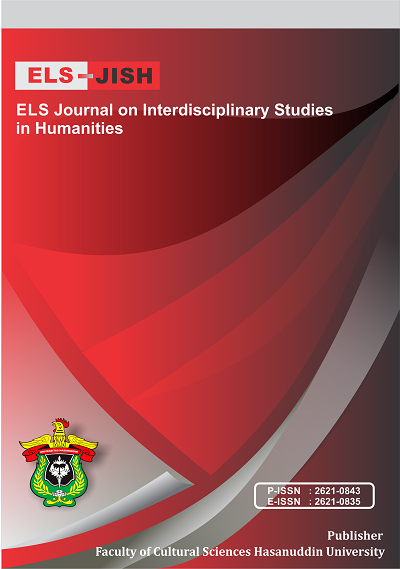Discursive Practice Used in Sermons of Waibu Moi Churches in Jayapura
DOI:
https://doi.org/10.34050/elsjish.v6i1.26016Keywords:
Discursive Practice, Preachers, Power of Language, Sermons, Waibu Moi ChurchesAbstract
Sermon has vital roles in educating the people of Papua in Jayapura. It is considered one of the legal ways effect the attitude of Papuan Christianity. Sermon conducted in Waibu Moi Churches of Jayapura contains power of language to ensure the life as Christianity. The power of language used by the preacher is seen by using discursive text analysis. The goal of this study is to present the language power used by the preacher in Waibu-Moi Churches of Jayapura. The method applied in this study was descriptive qualitative. The data was taken from 5 churches which have good management by using recording technique. The techniques of analyzing data were transcription, reducing, data display, and analysis. The Analysis of data used the theory of Fairclough, discursive dimensions, combined with the analysis of formal aspect of language namely experiential analysis. The results of this analysis show that the power of language used by the preachers in Waibu Moi churches are generally forms the features of analogy , cause and effect, affirmation statements, and code of language in mixing and switching.
References
Andini, C., Sosrohadi, S., Fairuz, F., Dalyan, M., Rahman, F. F., & Hasnia, H. (2022). The Study of Japanese Women in the Facial Treatment Advertisement: A Semiotics Perspective of Pierce’s Theory. ELS Journal on Interdisciplinary Studies in Humanities, 5(2), 337-347.
Coulthard, M., & Condlin, C. N. (2014). An introduction to discourse analysis. Routledge.
Fairclough, N. (2013). Critical discourse analysis: The critical study of language. Routledge.
Foucault, M. (1980). Power and Knowledge (ed). Harvester Press.
Hamuddin, B., Rahman, F., Pammu, A., Baso, Y. S., & Derin, T. (2023). Mitigating the effects of cyberbullying crime: A multi-faceted solution across disciplines. International Journal of Innovative Research and Scientific Studies, 6(1), 28-37.
Haryatmoko, D. (2016). Critical Discourse Analysis (Analisis Wacana Kritis): Landasan Teori, Metodologi, dan Penerapan. Jakarta: Rajawali Pers.
Kabanga, L., Sobe, M., & Moruk, Y. (2022). Extensive Flouting of Maxim Quantity in Media RRI of Jayapura. ELS Journal on Interdisciplinary Studies in Humanities, 5(2), 209-217. https://doi.org/10.34050/elsjish.v5i2.21300
Kabanga, L., Wenda, D., & Labobar, M. W. (2022). Informative Function in the Contents of Preachers ’ Sermons in Jayapura Churches. ELS Journal on Interdisciplinary Studies in Humanities, 5(3), 460–467. https://doi.org/10.34050/elsjish.v5i3.22276
Mukhlis, M., Masjid, A. Al, Widyaningrum, H. K., Komariah, K., & Sumarlam, S. (2020). Analisis Wacana Kritis Model Teun A.Van Dijk pada Surat Kabar Online dengan Tajuk Kilas Balik Pembelajaran Jarak Jauh Akibat Pandemi Covid-19. GERAM (Gerakan Aktif Menulis), 8(2), 73–85. https://doi.org/10.25299/geram.2020.vol8(2).5867
Putri, Sapen Sartika Unyi., Rosyidin, M., & Alfian, M. F. (2022). Praktik Diskursif Amerika Serikat dalam Membangun Narasi Terorisme Global : Studi Kasus Kejahatan oleh Ali Muhammad Brown dan Stephen Craig Paddock. Journal of International Relations, 8(1), 32–45. https://doi.org/10.14710/jirud.v8i1.32891
Rahman, F. F., & Rahman, F. (2019). Translation or Intertextuality: A Literature Comparative Analysis of “The Young Dead Soldiers Do Not Speak” by Archibald MacLeish and “Krawang Bekasi” by Chairil Anwar. Elsya: Journal of English Language Studies, 1(3), 110-117.
Rahman, F., & Weda, S. (2019). Linguistic deviation and the rhetoric figures in Shakespeare’s selected plays. XLinguage" European Scientific Language Journal", 12(1), 37-52.
Saddhono, K. (2017). Wacana Khotbah Jumat di Kota Surakarta: Sebuah Kajian Sosiopragmatik The Discourse of Friday Sermon in Surakarta: A Socio-pragmatic Study. In Perpustakaan UNS Surakarta (pp. 12–26).
Sahib, H., & Sahraeny, S. (2022). Denotational and Interactional Power of Speech in the Implementation of Customary Firmness. In 9th Asbam International Conference (Archeology, History, & Culture In The Nature of Malay)(ASBAM 2021) (pp. 458-464). Atlantis Press.
Sarasati, R. (2020). Analisis wacana kritis dalam pembelajaran: Peran AWK pada pembelajaran literasi kritis, berpikir kritis, dan kesadaran berbahasa kritis. HUMANIKA, 19(1), 20–29. https://doi.org/10.21831/hum.v19i1.30156
Silaswati, D. (2019). Analisis Wacana Kritis dalam Pengkajian Wacana. METAMORFOSIS | Jurnal Bahasa, Sastra Indonesia Dan Pengajarannya, 12(1), 1–10. https://ejournal.unibba.ac.id/index.php/metamorfosis/article/view/124
Sugiyono. (2018). Metode Penelitian Kuantitatif, Kualitatif, dan R&D. Alfabeta.
Sukmawaty, F. F. R., & Andini, C. (2022). Covid-19 Pandemic and Axiology of Communication: A Study of Linguistic Phenomena. IJISRT, 7(4), 1079-1087.
Supradi, Simanjuntak, B., & Yusrah. (2020). Analisis Wacana Kritis Pidato Nadiem Makarim 2019. Jurnal Sintaksis: Pendidikan Guru Sekolah Dasar, IPA, IPS Dan Bahasa Inggris, 2(2), 71–78. https://jurnal.stkipalmaksum.ac.id/index.php/Sintaksis/article/view/126
Thomas, L., & Wareing, S. (2004). Language, society and power: An introduction. Routledge.
Van Dijk, T. A. (1995). Aims of critical discourse analysis. Japanese Discourse, 1(1), 17–28.
Wenda, D., Kabanga, L., & Labobar, M. W. (2022). Fungsi Bahasa pada Konten Khotbah Pengkhotbah di Jemaat-Jemaat Lingkungan Kota Klasis Sentani. Diglosia: Jurnal Kajian Bahasa, Sastra, Dan Pengajarannya, 5(4), 793–806. https://doi.org/10.30872/diglosia.v5i4.483
Downloads
Published
Issue
Section
License
Copyright (c) 2023 Berthin Samuati Banga, Lewi Kabanga', Simon Tabuni

This work is licensed under a Creative Commons Attribution-ShareAlike 4.0 International License.






